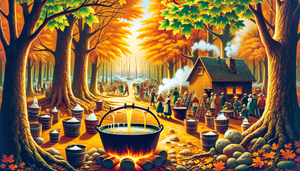Early Maple Syrup Festivals
Jul 23, 2024
Maple syrup has long been a cherished delight, particularly among foodies, breakfast enthusiasts, and culinary artisans. Its rich, golden sweetness not only enhances flavors but also evokes a sense of nostalgia and connection to nature. This blog post explores the early maple syrup festivals, celebrating Vermont maple syrup production's traditional and artisanal methods. These festivals offer a comforting, welcoming glimpse into the history and culture of the sugaring season.
The Origins of Maple Syrup Festivals
The earliest maple syrup festivals date back to the 19th century, reflecting a deep-rooted tradition in North American culture. These festivals were community gatherings where families and friends celebrated the end of winter and the beginning of the sugaring season. They provided an opportunity to showcase the labor-intensive process of syrup production, from tapping the maple trees to boiling down the sap.
Key Features of Early Maple Syrup Festivals
- Community Gatherings: These festivals allowed communities to unite after a long winter. People would share stories, food, and the first batches of the season's syrup.
- Educational Demonstrations: Early festivals featured demonstrations of traditional syrup-making techniques. Attendees could watch the process of collecting sap, boiling it down, and filtering the syrup.
- Tasting and Sampling: A highlight of these festivals was the opportunity to taste fresh maple syrup, often drizzled over pancakes, waffles, or snow (a treat known as "sugar on snow").
Traditional Syrup-Making Methods
At the heart of these festivals was the traditional method of syrup production. This process passed down through generations, involved:
- Tree Tapping: Sugar maple trees were tapped in early spring to collect sap. A small hole was drilled into the tree, and a spout was inserted to direct the sap into a bucket.
- Sap Collection: The sap was collected daily and transported to a sugarhouse, where it was stored until enough was gathered for boiling.
- Boiling: The sap was boiled in large pans over an open fire or a wood-fired evaporator. This process evaporated most of the water, concentrating the sugars into syrup.
- Filtering and Bottling: The syrup was filtered to remove impurities and then bottled for use or sale.
Celebratory Activities and Traditions
Beyond the production of syrup, early maple syrup festivals were rich with cultural traditions and celebratory activities:
- Music and Dancing: Local musicians often provided entertainment, and community dances were a common feature, fostering a sense of camaraderie and celebration.
- Crafts and Artisan Goods: Festivals showcased local crafts and artisan goods, from handmade quilts to wood carvings, celebrating the community's creativity and skills.
- Family Activities: Families can engage in various activities, such as horse-drawn sleigh rides, games for children, and guided nature walks to learn about maple tree ecology.
The Legacy of Maple Syrup Festivals
Today, the spirit of these early festivals lives on in modern celebrations. Contemporary maple syrup festivals continue to honor traditional methods while incorporating new elements such as:
- Educational Workshops: Modern festivals often include workshops on sustainable farming practices, the science of maple syrup production, and cooking demonstrations.
- Expanded Tasting Options: Visitors can enjoy a wider variety of maple products, including maple candies, maple-infused beverages, and gourmet maple dishes.
- Interactive Experiences: Interactive experiences such as DIY syrup tapping kits and guided tours of sugarhouses provide a hands-on understanding of the syrup-making process.
FAQs
Q: When is the maple sugaring season? A: The maple sugaring season typically begins in late February and lasts through early April, depending on the region and weather conditions.
Q: How much sap is needed to make one gallon of syrup? A: It takes approximately 40 gallons of sap to produce one gallon of maple syrup.
Q: Are there different grades of maple syrup? A: Yes, maple syrup is graded based on its color and flavor, ranging from light and delicate to dark and robust.
Q: Can I visit a maple syrup festival today? A: Absolutely! Many regions, especially Vermont and other northeastern states, host annual maple syrup festivals celebrating this sweet tradition.


